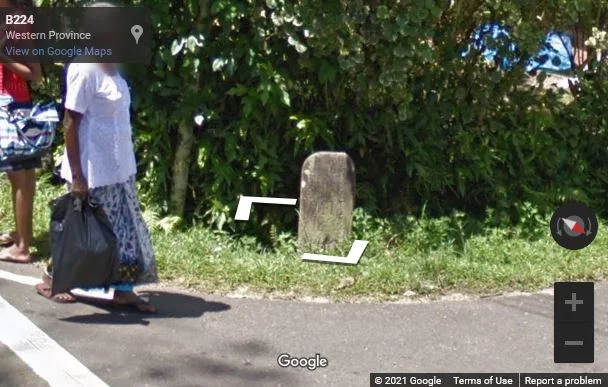
Keselhenawa slab inscription (Photo credit: Google Street View)
Keselhenawa Raja Maha Viharaya (Sinhala: කෙසෙල්හේනාව රජමහා විහාරය) is a Buddhist temple situated in Keselhenava village in Kalutara District, Sri Lanka.
History
Locals link the history of this temple to Deva Pathiraja, a minister of King Parakramabahu II (1236-1270 A.D.). It is said that Deva Pathiraja built a bridge 100 staves (750 feet) in length at Kadalisenagama or Kelsenava [(modern Keselhenawa) Nicholas, 1963]. The stone-cut Samadhi Buddha statue in the temple image house is believed to be a work of the time of Parakramabahu II. However, this statue is presently covered by cement plaster. It is also believed that this temple stands on the land where the abode of
Weerasingha Pathiraja, a minister of Parakramabahu II was located. A few artefacts which are supposed to be used by Weerasingha Pathiraja have been unearthed from this site. A flag representing Raigampura is said to have been found in the repository of this temple.
A large copper cauldron which was brought from Sri Pada in 1850 by a monk named Kosgama Dhammakkhanda Thera is presently preserved on the temple premises.
Keselhenawa slab inscription
This inscribed slab is found on the left-hand side of the junction turning to the Keselhenawa temple on the Keselhenawa-Yala road. The inscription consists of five lines of writing. Below the writing are the years 2411 (Buddhist year) and 1868 (Common year). A sketch of a hand showing the direction to the temple is denoted at the bottom of the slab.
Period: 19th century A.D. Script: Modern Sinhala Language: Modern Sinhala
Transcript: Kesel lenawe viharasthanayata yana para me. Sri Buddha varsh 2411. 1868
Translation: This is the way to the Keselhenawa Viharaya. Sri Buddhist Year 2411. 1868.
References: Gamage, 2020.
A protected site
The ancient image house in the Keselhenawa Purana Raja Maha Vihara in Eudugoda in Grama Niladhari Division of Hallan Kanda bearing No. 648 B in the Madurawala Divisional Secretariat Division is an archaeological protected monument, declared by a government gazette
notification published on 23 February 2007.
References
1) Gamage, D.P., 2020. Epigraphical Notes (Nos. 22-23). Department of Archaeology. ISBN: 978-955-7457-30-7. pp.72-73.
2) Nicholas, C. W., 1963. Historical topography of ancient and medieval Ceylon. Journal of the Ceylon Branch of the Royal Asiatic
Society, New Series (Vol VI). Special Number: Colombo. Royal Asiatic
Society (Ceylon Branch). p.118.
3) The Gazette of the Democratic Socialist Republic of Sri Lanka, no: 1486. 23 February 2007. p.123.
Location Map
This page was last updated on 22 December 2022

